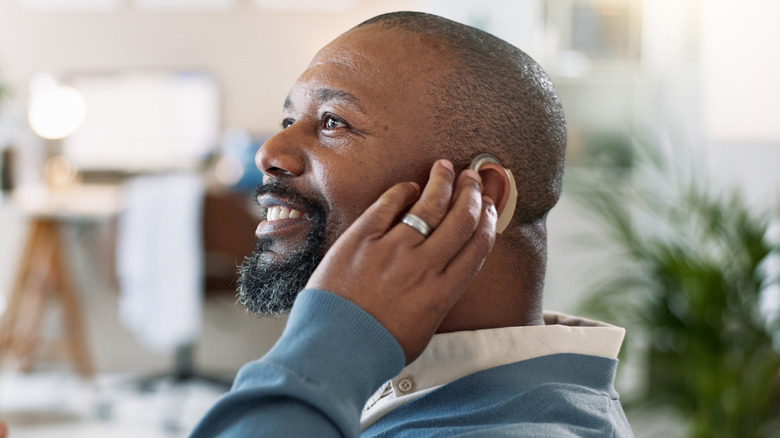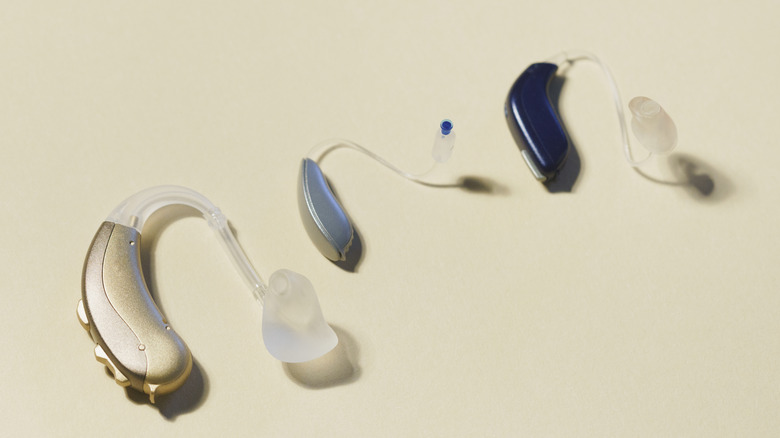$100 Vs. $1,000 Hearing Aids: What To Know Before Buying An OTC Model
Hearing aids are a vital adaptive tool for hearing loss, and there is a wide range of devices on the market, with equally varying price points. Depending on exactly what you're looking for, you can pick them up for as little as $50 or as much as $7,500 per pair. Consequently, knowing exactly how much to spend — or how much you actually need to spend — on your devices can be challenging; even more so if you're picking them up over the counter rather than on prescription.
With some hearing aids hitting around the $100 mark, it's easy to wonder if more expensive models are actually worth it. The answer isn't straightforward or simple — it depends on exactly what you're looking for, your needs, and the device's features. More expensive hearing aids will often include self-fitting features, like an accompanying app, for example. Cheaper hearing aids, on the other hand, tend to amplify the surroundings regardless of your specific hearing loss or based on generic pre-programmed presets. This is the main difference between more expensive and cheaper hearing aids, with other differences appearing on a device-by-device basis.
Although investing in more expensive hearing aids can be worthwhile, and adapting your aids to your specific needs is important, it's generally still better to have something that fits your budget than nothing at all. Other concerns vary on a more individual basis, rather than by budget. For instance, some more expensive options like the Lexie Lumen use disposable batteries, while slightly more affordable options such as the Elehear Beyond are rechargeable. So, be sure to break down the exact variation between each model before buying. And, if you're not looking for a bespoke experience, then a cheaper option might do just the trick.
Comparing budget and top-end hearing aids
There are a couple of different well-regarded hearing aids available for around $1,000. The in-the-canal (ITC) Sony CRE-C20 Hearing Aids were titled the "Best In-the-Ear Hearing Aids" by Wired, who also rated them 8/10. While they're expensive, they are rechargeable, meaning you won't need to worry about buying specialist batteries each week. They hold around 28 hours per charge. There are other upkeep costs, of course, such as buying replacement pipes or ear-tips. Notably, the CRE-C20s don't come with open ear tips, so you will need to budget that in if you prefer them. Another pair — the Lexie B2 Plus — falls in a similar price range at $999. Audiologists.org rated this set as having the best app and user experience, courtesy of its intuitive app.
A more affordable set of hearing aids also received an 8/10 when tested by Wired, earning them the title of 'Best Budget Hearing Aids'. The JLab Hear cost around $100 and double-up as wireless earbuds. They don't offer a totally customized hearing aid experience, as you can't upload an audiogram or tune it to a test. However, you can change presets so that sounds are more or less amplified, and to control the amount of noise cancellation.
The app also offers an equalizer for any fine-tuning. They're FDA-approved and tend to outperform other budget options on tests, like the Audien Atom One that Wired rated 5/10, so they could be useful if you don't need a completely customized experience. Or, they could be a useful tool to have in addition to aids that are fitted to your hearing range, because of their earphone functionality.
Are personalized hearing aids important?
Being able to tailor hearing aids with a test or audiogram is especially important if your hearing loss is focused around particular frequency ranges. For instance, if you mostly experience hearing loss around higher-frequency ranges — so you can't hear lower-pitched sounds that clearly — then devices that boost the volume of your surroundings generally might not be very useful for you. This is because higher-frequency sounds, which you may hear more clearly, will also be boosted, meaning the sound could be overwhelming or muddy. Personalizing your hearing aids to your specific loss helps to make sure you get the support you need.
Other, non-custom-enabled devices might be set up specifically for the sloping tuning, which will work well for some people. This is a common type of hearing loss where the upper range is limited, meaning higher-pitched noises may be inaudible or obstructed. Hearing aids that can't be personalized are often tuned this way. The $200 Earcentric hearing aids are an example of this, according to Soundly, which noted that the non-personalizable devices would only be useful for those looking for aids with the sloping configuration.
If you need to customize your hearing aids, but your budget can't stretch to higher-end models, then you still have some options. The Apple AirPods Pro 2 have a hearing aid feature which is set up with an in-app hearing test. They come in at $250, making them more affordable than top-end models. Despite that, Wired reported on their sound quality, unfortunately including hisses and artifacts. Audio artifacts are audible glitches and other noise that appear when sound is processed. They're particularly problematic when it comes to hearing aids, as they should sound as natural and lifelike as possible.


